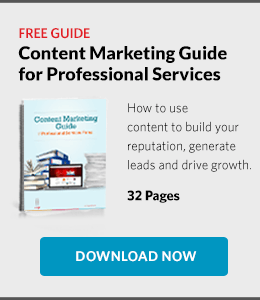How to Create a B2B Case Study that Boosts New Business

Did you know that 84% of buyers say they won't interact with a brand unless they trust it? Or that more than one third of buyers trust a stranger's opinion more than a brand's?
So how do you get professional services buyers to trust your firm?
You create case studies. Case studies use the voice of “others” (i.e. your satisfied clients) to tell prospects why they should trust your firm and buy your services.
In a recent research study, Hinge Research Institute asked buyers of professional services to identify the best ways to market to them. By a wide margin, professional services buyers reported that “developing a reputation for producing results” was the best way to market to them, far more effective than forging a personal relationship.

Used effectively, case studies are one tool that can build trust and help you develop a reputation for producing results. A strong case study should communicate enough about your expertise and approach that people feel they know you even if they haven’t worked with you.
So let's look at how to create a compelling case study.
1. Identify the Right Partner
The first thing is to identify a client with compelling results or an innovative project. Talk to your business development and account management teams to find clients who would make excellent case studies.
In addition to having a compelling story to tell, a client that your firm has a close relationship with or who frequently comments on how happy they are with your firm's services may be more willing to participate. So if you have several choices, weigh your relationship with the client into the decision process.
SEE ALSO: How to Create Compelling Technology Client Case Stories
The person at your firm with the best relationship with the client should ask the client to participate and approve the case study before it's published. If that isn’t possible, the person reaching out to client should mention name of person the client has a relationship with.
Send the client interview questions in an email to help them determine whether they feel comfortable participating. Also make sure to emphasize the potential benefits to their business. Let them know where and how you'll distribute the case study, as this may offer some free positive publicity for their company.
2. Develop the Right Questions
Create questions for the client regarding the challenges they faced prior to using your services, the solutions you provided, and the results they achieved.
Be sure to ask the client about quantitative results, such as if they improved productivity by 20%, or saved $25,000, as those are the most compelling for readers.
Some sample questions might include:
- What challenges did you face that led you to look for a solution like ours?
- Describe the selection process and why your company decided to use our firm.
- What are some tangible results that our firm's services helped you achieve? Did you save time or money?
- Describe the experience you had working with our firm.
3. Interview Your Subject
Work with your client to identify who in their firm is best to talk with for your case study. It may not always be the same as the person who will be reviewing and approving the case study.
It may also be necessary to interview more than one person to get all the information you need to create a strong case study. Then, put your journalist hat on and interview client.
If client gives permission, record the interview. Being able to play the interview back later when writing case study will be helpful.
During the interview, ask follow up questions as appropriate to dig deeper into particularly compelling details. You are creating a story as much as a case study, so capturing small details will be helpful when you sit down to write.
4. Create a Compelling Story
Like any good content, your case study should engage the reader through storytelling. It should also point out the business benefits gained by using your firm's services. Finally, a good case study should develop trust that these benefits are achievable through the use of concrete results and the affirmation of a happy client.
At Hinge, we use the formula: situation + process = results to ensure we've covered all the key points in our case studies.
1) Describe the challenge. We start by describing the situation or challenge our client faced and why we were the preferred firm of choice (i.e. our distinguishing factor).
Example: Beardsley, a 100-year old, New York-based architecture and engineering firm, came to Hinge to create a new brand that respects their past and positions them for the future.
They offered a full suite of design services for government, healthcare, education and residential clients — from conception to construction. But Beardsley’s strength was also its weakness. Their breadth of services made it difficult to stand out in the industry. Our challenge was to help them find a niche that aligned with their history, without sacrificing their comprehensive design services.
Read full Beardsley case study here
2) Explain how you helped the client. Then, we move into the process we used to help a particular client. This section will likely be the longest and most detailed. It will show prospects what they can expect when they work with you.
Example: Hinge began by conducting internal and external research, interviewing MicroLink employees as well as existing and potential clients. The research gave Hinge an insight into external and internal brand perception gaps and an understanding of customers’ buying habits. While MicroLink’s clients were satisfied with the company’s level of expertise and service, Hinge determined that clients were not able to articulate what the company did or why its services were important…
Read full MicroLink case study here
3) Show results. Finally, we show how this process and our expertise produced results for the business.
Example: Over an 18-month period, this strategy has dramatically increased the firm's online presence, creating an influx of traffic, high-quality leads and new clients. Over a recent 4-month period, social media activity created 170 new leads.
Read full Digital Accomplice case study here
Once, you've taken the time to create a few case studies, you'll begin to see just how strong they can be in developing trust. Even better, you'll see how they help bring new clients in the door.
To learn more strategies for nurturing your prospects through the buying cycle, download a free copy of the Content Marketing Guide for Professional Services.
On Twitter or LinkedIn? Follow us @HingeMarketing and join us on LinkedIn.
Industries & Topics
Most Popular
- Business Development Strategy: A High-Growth Approach
- A 10 Step Brand Development Strategy for Your Professional Services Firm
- Strategic Marketing for Professional Services
- Digital Branding for Professional Services
- 10 Essential B2B Marketing Strategies to Grow Your Professional Services Firm
- Digital Marketing Strategy for Professional Services
- Rebranding Strategies: A Step-By-Step Approach for Professional Services
- Elements of a Successful Brand 1: Brand Positioning
- The Top 5 Business Challenges for Accounting & Financial Services Firms
- Find Your Differentiator: 21 Ways to Gain a Competitive Advantage for Your Firm
- Elements of a Successful Brand 4: Brand Promise
- What Is the Cost of Video Production for the Web?







Leave a Comment